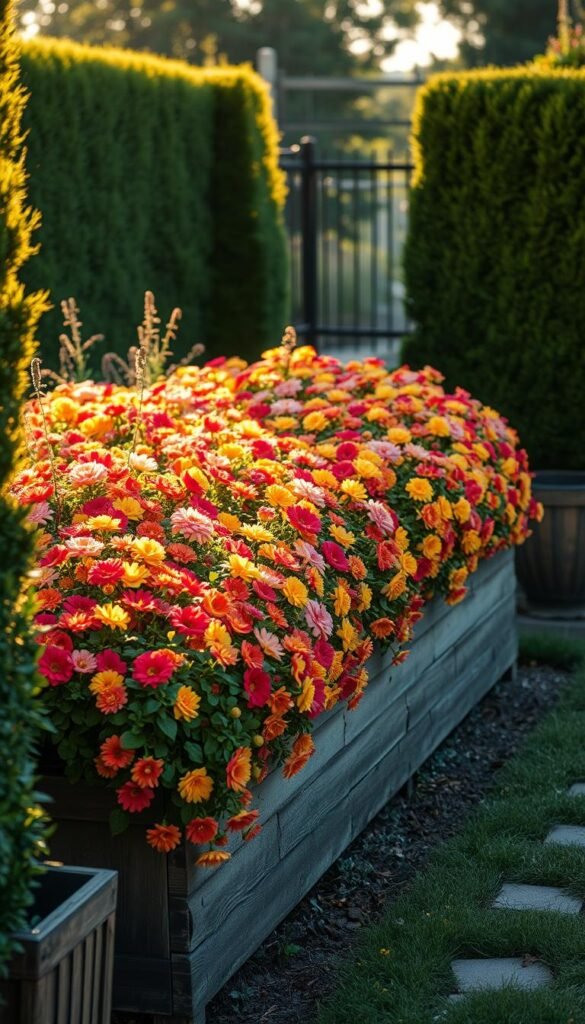Imagine tending to vibrant blooms without straining your back or knees. Elevated planters offer a fresh approach to growing colorful displays while keeping maintenance simple. These structures bring your favorite blossoms to eye level, creating living art that enhances your yard’s beauty and functionality.
One major advantage is improved ergonomics. You’ll spend less time bending and more time enjoying your outdoor oasis. Better soil drainage helps plants thrive, and built-in barriers keep pests at bay. Whether you’re working with a cozy patio or sprawling lawn, these solutions adapt to any space.
Materials range from rustic cedar to sleek metal, letting you match your landscape’s style. Our step-by-step construction guide shows how to create durable designs using weather-resistant options. Thoughtful layouts can even extend your growing season naturally.
Discover clever ways to arrange eye-catching arrangements that bloom longer and require less upkeep. From cascading petunias to bold dahlias, elevated setups make nurturing nature’s beauty easier than ever. Let’s explore how to blend practicality with creativity in your green space.
Create Ergonomic Garden Beds for Back-Friendly Planting
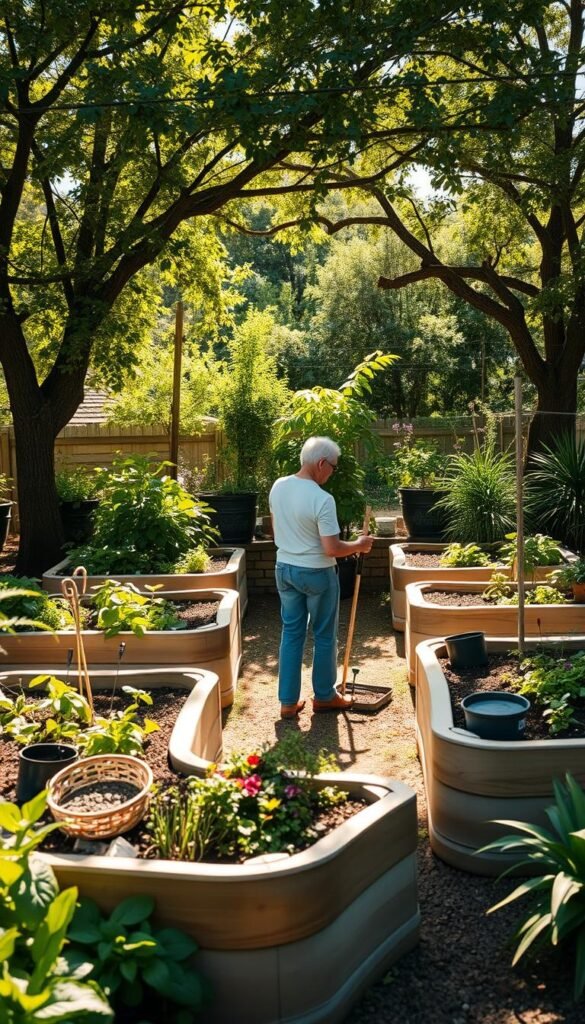
Ever finish a gardening session feeling like you need a chiropractor? Modern designs let you nurture your plants without sacrificing comfort. The secret lies in smart height adjustments that keep your spine happy while you work.
Waist-Height Solutions for Improved Comfort
Building your bed at 30-36 inches changes everything. This range lets you tend to soil and plants while standing straight. No more kneeling on hard ground or bending awkwardly to reach ground-level planting areas.
| Traditional Setup | Ergonomic Design | Key Benefit |
|---|---|---|
| Ground-level work | Waist-high access | Reduces back strain |
| Limited visibility | Eye-level monitoring | Easier pest control |
| Kneeling required | Standing-friendly | Better mobility |
Techniques to Reduce Bending and Strain
Try these beds easy on your body:
- Install vertical planters for trailing varieties
- Use long-handled tools from standing position
- Add wide edges for sitting while working
Grandparents and young adults alike find this way of gardening more enjoyable. You’ll spot discolored leaves or unwanted bugs faster when your garden sits at eye level. Harvesting becomes a breeze – simply pluck blooms at arm’s reach!
Raised Bed Flower Garden Inspiration: Higher Beds for Easier Care
Transform your outdoor space with structures that blend beauty and practicality. Elevated planters let you arrange flowers at perfect viewing height while keeping soil quality in check. You’ll notice fewer weeds and better moisture control compared to traditional setups.
Smart layouts turn functional spaces into artistic statements. Try curved edges or tiered arrangements to guide the eye through your landscape. These designs naturally separate areas of your yard, creating intimate seating nooks or vibrant entryway features.
| Traditional Planting | Elevated Design | Advantage |
|---|---|---|
| Flat ground layout | Vertical dimension | Better air circulation |
| Limited pest barriers | Built-in protection | Fewer critter issues |
| Single-level access | Multi-height options | Custom plant needs |
Mix textures and colors for maximum impact. Pair spiky lavender with trailing nasturtiums in your flower bed, or cluster bold dahlias with delicate alyssum. The vertical element adds depth, making small yards feel larger and more organized.
These planters work wonders in tricky spaces. Brighten up narrow walkways with slim rectangular boxes, or frame patios with U-shaped installations. You’ll love how easy it becomes to refresh seasonal displays without digging through compacted earth.
Incorporate Vertical Supports with Trellises and Grid Wiring
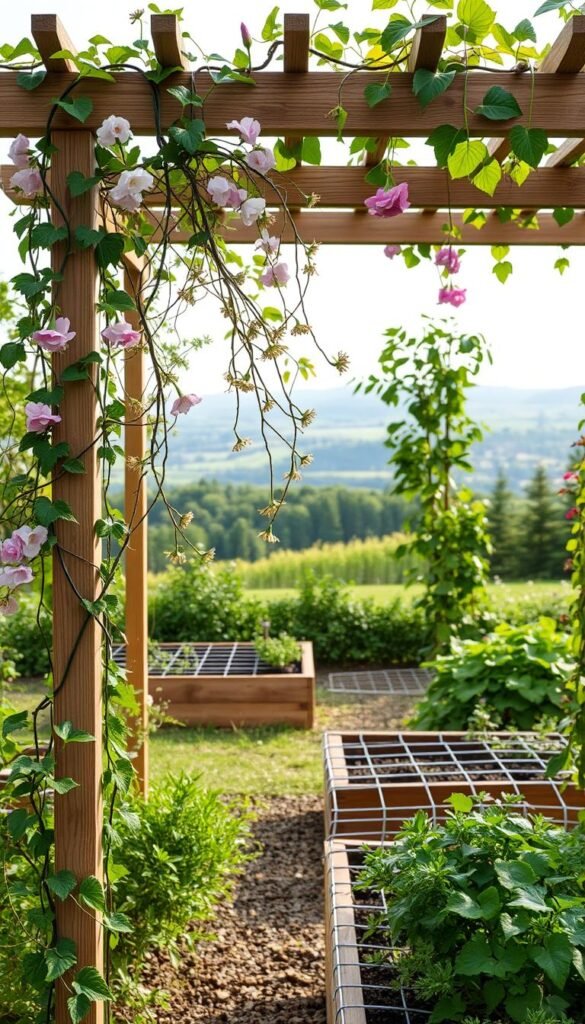
Elevate your green space by guiding plants upward—literally. Vertical structures transform how greenery grows while keeping your setup tidy. These supports work like invisible hands, directing growth patterns and boosting air flow between stems.
Enhance Climbing Plants with Vertical Support
Wood, metal, or bamboo frames give vines the perfect climbing surface. Morning glories wind through lattice patterns, while clematis grips rough-textured posts. You’ll notice healthier growth as leaves spread toward sunlight instead of crowding the soil.
Install these supports early in the planting process. Young tendrils naturally seek guidance, creating structured growth habits. For heavy bloomers like climbing roses, choose powder-coated steel that withstands weight and weather.
Keep Your Garden Organized and Lush
Grid systems act as blueprints for your bed. Create planting zones using crisscrossed wires or removable dividers. This method prevents overcrowding and lets you rotate crops efficiently.
Here’s why it works:
- Sunlight reaches lower leaves through spaced vines
- Air circulation reduces fungal risks
- Harvesting becomes simpler with clear access paths
Discover how to use a trellis effectively for tomatoes or flowering vines. These structures disappear under summer growth, leaving only vibrant foliage and blossoms. Your space stays neat while supporting ambitious climbers.
Explore Creative Materials: Brick, Stone, and Galvanized Options
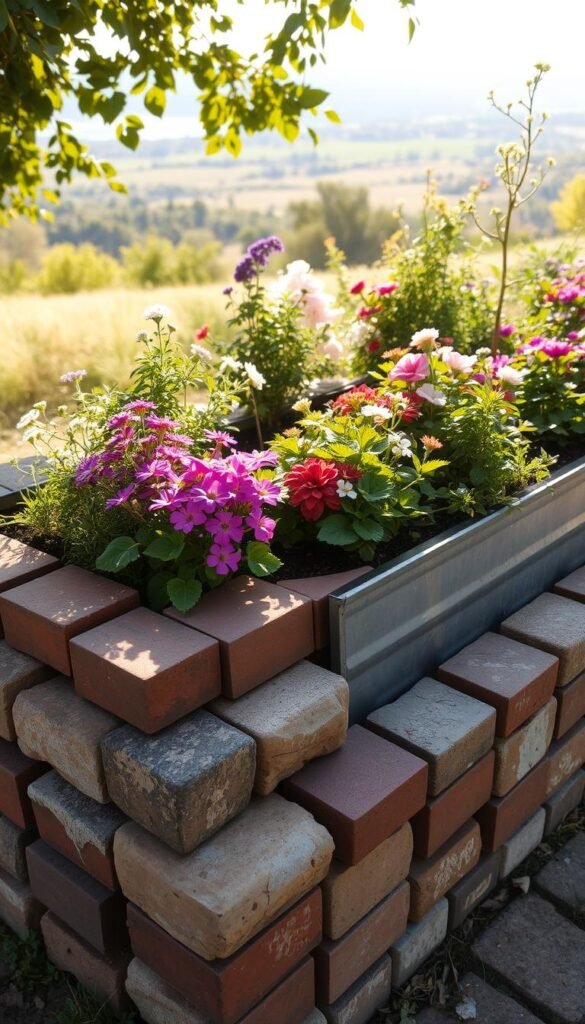
Your outdoor space becomes a design canvas when selecting structures that complement your home’s character. The right materials balance visual harmony with practical benefits, transforming functional planters into striking landscape features.
Rustic Brick and Stone for Seamless Hardscaping
Natural stone or reclaimed brick blends effortlessly with existing walkways and patios. These materials develop a weathered charm over time while offering unmatched durability. Landscape architect Stacy Paetzel notes: “Lining the base with galvanized hardware cloth prevents burrowing pests from damaging roots while maintaining drainage.”
| Material | Lifespan | Style Match | Maintenance |
|---|---|---|---|
| Brick | 25+ years | Traditional homes | Low |
| Stone | 50+ years | Rustic landscapes | None |
| Galvanized Steel | 20+ years | Modern designs | Minimal |
Modern Galvanized Planters for a Unique Appeal
Sleek metal troughs bring industrial flair to contemporary spaces. Their reflective surfaces warm soil faster in spring, giving heat-loving blooms a head start. Unlike wood, these planters resist rot and insects – perfect for budget-friendly square-foot gardening setups.
Pair angular metal planters with flowing ornamental grasses for textural contrast. The crisp lines create visual order in wild cottage-style arrangements, proving functionality and beauty coexist effortlessly.
Space-Saving Raised Bed Ideas for Compact Yards
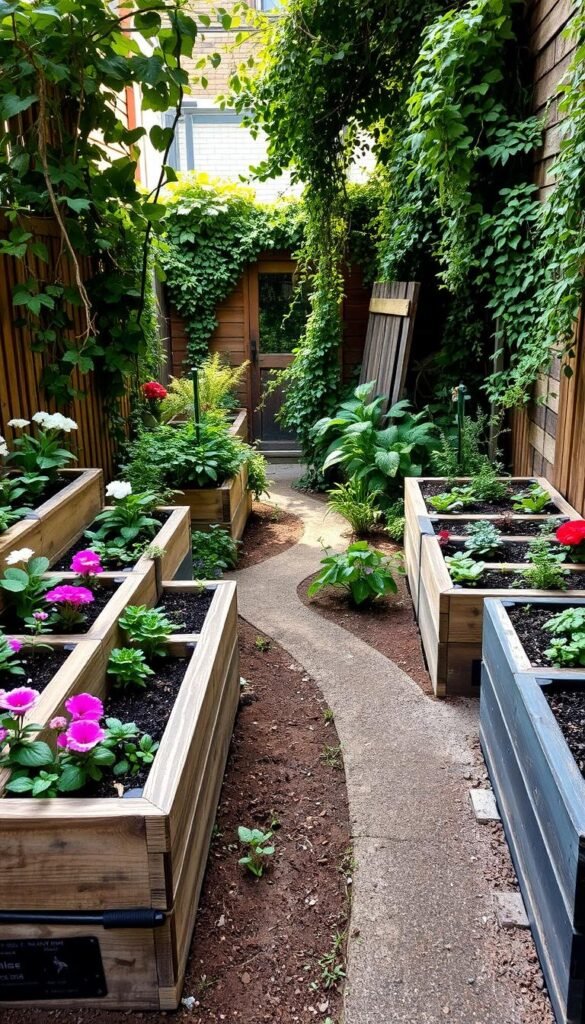
Short on outdoor space but craving lush blooms? Unconventional planter shapes turn forgotten corners into thriving green zones. Australian gardener Ashenden Burke proves even small plots can flourish, using geometric designs that squeeze functionality into tight areas.
Triangular Beds and Unconventional Shapes
Angle-based designs unlock hidden potential. A triangular structure fits snugly against fences or between walkways, creating planting zones where traditional rectangles won’t work. You’ll gain up to 30% more growing area in awkward spaces.
| Shape | Best For | Space Gain |
|---|---|---|
| Triangle | Corner areas | 25-40 sq ft |
| Hexagon | Group plantings | 15% efficiency boost |
| Curved | Path borders | Natural flow |
Circular planters soften hardscapes while maximizing soil depth. Arrange several in staggered patterns to guide foot traffic naturally. Diamond-shaped layouts add modern flair, especially when mixing flowering plants with herbs.
Benefits you’ll love:
- Custom configurations for unique yard layouts
- Built-in pathways between angled edges
- Visual drama through contrasting forms
Burke’s wooden hexagon planters demonstrate how geometric patterns create rhythm. “The right shape turns limitations into design opportunities,” he notes. Your compact area becomes a curated showcase, not just a cramped patch.
Tailor Planter Heights to Your Plants’ Needs
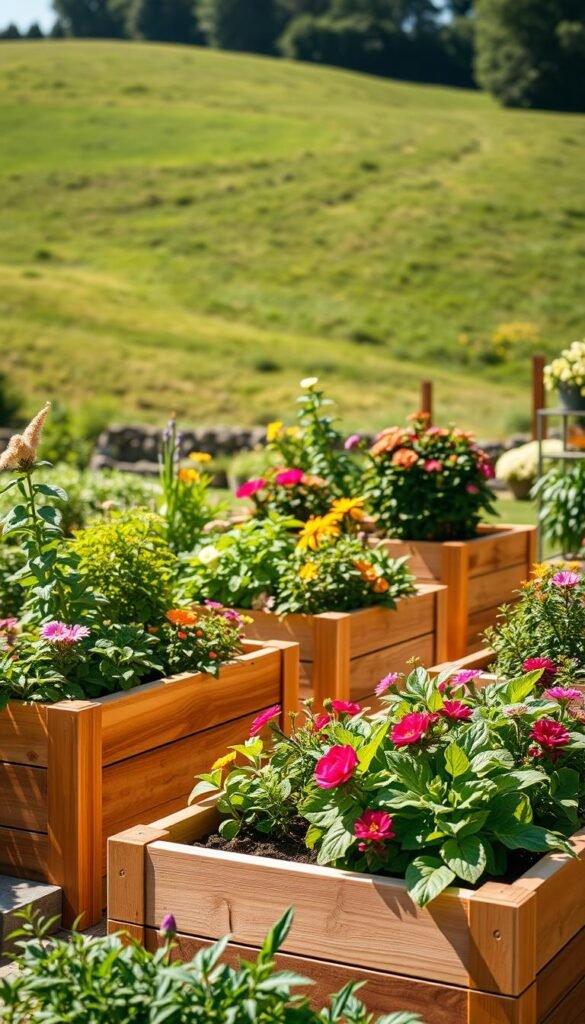
Your green space thrives when planters match your greenery’s needs. Custom depths let roots spread comfortably while creating dynamic visual layers. Landscape designer Janice Parker notes: “Contrasting heights guide the eye through your space like nature’s staircase.”
Deep Versus Shallow Beds for Diverse Plantings
Root depth dictates success. Delicate annuals thrive in 6-inch setups, while bold perennials demand 18-inch foundations. Stacy Paetzel advises: “Match soil volume to growth patterns – shallow lettuces won’t compete with deep-rooted showstoppers.”
| Plant Type | Ideal Depth | Top Picks |
|---|---|---|
| Annuals | 6-8″ | Petunias, pansies |
| Bulbs | 10-12″ | Tulips, daffodils |
| Perennials | 12-18″ | Peonies, daylilies |
Mix depths in adjacent planters for practical beauty. A tall cedar box bursting with lupines pairs perfectly with low-maintenance flowers in shallower companions. You’ll create microclimates that suit each species.
Material Choices That Complement Your Landscape
Select surfaces that harmonize with your home’s architecture. Dark-stained wood makes gravel paths pop, while corten steel echoes modern façades. Consider these factors:
- Durability – metal outlasts untreated lumber
- Drainage – porous stone prevents soggy soil
- Style cohesion – match existing deck materials
Janice Parker’s signature dark walnut planters demonstrate how rich tones anchor vibrant blooms. Your material palette becomes the frame for nature’s artwork, blending function with curb appeal.
Integrate Multi-Level Designs with Steps and Tiers
Turn your yard into a living sculpture with layered layouts that add depth and movement. Stepped garden structures transform flat spaces into dynamic displays, while sloped areas become opportunities for creative landscaping solutions. You’ll love how stone pathways wind through cascading blooms, making every angle photo-worthy.
Three-tiered bed arrangements create natural focal points. Upper levels bask in full sun for heat-loving varieties, while shaded lower sections host ferns or hostas. This smart design mimics nature’s elevation changes, giving each plant group ideal conditions.
| Design Type | Best Use | Key Benefit |
|---|---|---|
| Stepped stones | Sloped yards | Erosion control |
| Stacked planters | Small spaces | Vertical growth |
| Curved tiers | Flat landscapes | Visual flow |
Water management becomes effortless with gravity-assisted drainage. Rainwater trickles from top beds to lower ones, keeping roots hydrated without soggy soil. Add decorative boulders between levels for texture contrast and seating spots.
Hardscaping elements like retaining walls do double duty – they stabilize soil and showcase your favorite trees or shrubs. You’ll create year-round interest as flowering annuals give way to evergreen structure in colder months.
Enhance Your Garden with Lighting and Colorful Planters
Extend your outdoor enjoyment into the evening hours with strategic design touches. Thoughtful accents transform functional spaces into inviting retreats while highlighting your favorite botanical features.
Create Ambiance with String Lights
Texas gardener Rhonda Kaiser proves fairy lights aren’t just for holidays. Drape weatherproof strands above your bed to cast a warm glow on evening blooms. This simple upgrade turns your garden into a magical setting for sunset gatherings or quiet relaxation.
Add Vibrant Colors to Draw the Eye
Metal containers do double duty – they protect plants from critters and inject personality. Choose cobalt blue for Mediterranean vibes or rust-red troughs for modern contrast. These durable pieces maintain their style through seasons, framing your flowers like living artwork.
Pair glossy finishes with matte foliage for textural interest. You’ll love how morning dew sparkles on metallic surfaces, adding unexpected dimension. Whether hosting friends or savoring solitude, these finishing touches make every moment outdoors feel special.

